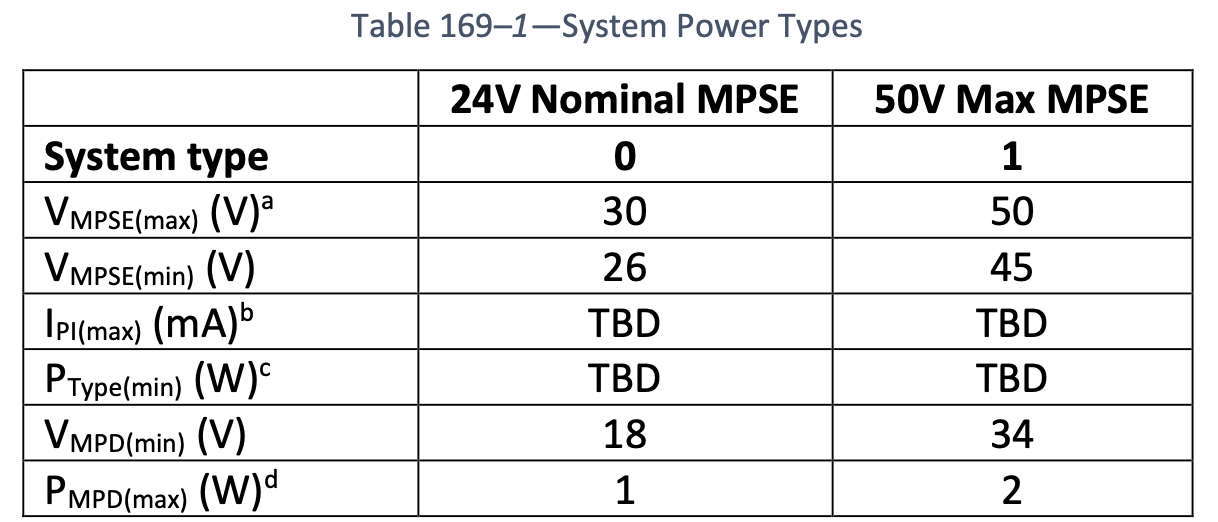Zach, discussion here is encouraged, thanks for your reply.
You are correct in that I left out the power lost to the cable in my rough estimates for MPD power. That additional loss further exacerbates problem, as incremental power is allocated to the mixing segment.
This means the numbers in my previous email are best case numbers…
You are mistaken to use the min MPD voltage to calculate MPD power. I was also careful to state I was talking about guaranteed MPSE power. The Min MPD voltage is what the last MPD on the mixing segment might
see, but not what every MPD will see. It hurts the head at times to think about this as the number of elements get hard to juggle. I’ve assembled a spreadsheet to help better estimate what a system might get per PD, I expect to write an annex at some point
and post that spreadsheet on the 802.3 site which 802.3 customers could use to help better engineer their system. It’s part of a bigger issue I have with the draft and unit loads, but that’s a whole other rathole that I will avoid right now.
Restricting the minimum MPSE voltage isn’t a burden on MPDs or MPSEs. It’s a burden on the power supply one might use to power the MPSE. My recollection of the discussion over time was that it’s a small burden
to insist the MPSE supply has a tighter “minus” tolerance than to cripple every installation by making the lower limit artificially low. What’s the reality that you’ll encounter a “24 V system” at 21.6 volts?
Regards,
Chad Jones
Principal Engineer, Cisco Systems
Executive Secretary, IEEE 802.3 Working Group
Chair, IEEE P802.3da Task Force
Principal, NFPA 70 CMP3
From:
Zach Pan <00003dccdc202a28-dmarc-request@xxxxxxxxxxxxxxxxx>
Date: Wednesday, January 8, 2025 at 11:36 AM
To: STDS-802-3-SPMD@xxxxxxxxxxxxxxxxx <STDS-802-3-SPMD@xxxxxxxxxxxxxxxxx>
Subject: Re: [802.3_SPMD] D2.0 comments 297 and 269
Newbie here. Not sure if I am supposed to reply to this email or use a different channel for my comments. Please let me know.
This is a topic that Schneider are closely followed. In our industrial drive or other equipment, 24V is a commonly used auxiliary power supply voltage, with a typical tolerance
band of -10% to +20%, which translates to 21.6Vmin and 28.8V max. So, we appreciate the comment that calls out that change. Otherwise, it will break the voltage compatibility and require us to add some unnecessary circuit to satisfy a 26V VMPSE(min).
As for the concerns of max power for MPD. It is limited by VMPD(min) and IMPSE(min), which is 16V and 1A in the draft D2.0. 16 W is the limit of type 0 configuration anyway,
and the user are supposed to use type 1 for higher power anyway. So I don’t see the change of VMPSE(min) have any negative impact on that.
Of course. The large gap between VMPSE(min) and VMPD(min) would allows longer wire and higher resistance drop on the wire. The proposed change would reduce the voltage drop
allowed on the wire from 10V to 5.6 V, which means the max wire resistance allowed changes from 10Ohm to 5.6 Ohm. I don’t see that as a problem, but we could specify a minimum wire size for given wire length to guarantee that is meet.

|
Best regards,
Zach Pan
|
|
|
Power Electronics Expert
Energy Management Business
Schneider Electric
|
M +1-714-876-4980
E zach.pan@xxxxxx
MS TEAMS zach.pan@xxxxxx
|
|
 1101
Shiloh Glenn Dr, Suite 100, Morrisville, NC 27560, United States 1101
Shiloh Glenn Dr, Suite 100, Morrisville, NC 27560, United States
|

|
General
From: Chad Jones (cmjones) <00000b60b3f54e8d-dmarc-request@xxxxxxxxxxxxxxxxx>
Sent: Wednesday, January 8, 2025 9:26 AM
To: STDS-802-3-SPMD@xxxxxxxxxxxxxxxxx
Subject: [802.3_SPMD] D2.0 comments 297 and 269
[External email: Use caution with links and attachments]
These two comments assert that the VMPSEmin voltage should not be 26 V but instead should be 21.6 V. I dug through the history and this text was added in Nov 2023, via this presentation:
https://www.ieee802.org/3/da/public/1123/clause169_clean.pdf (though there is a presentation there with markups and I don’t recall if this is something we marked up during the meeting
and imported the edited version:
https://www.ieee802.org/3/da/public/1123/clause169_edits.pdf). Regardless of which file was used, Table 169-1 is the same in both locations:

So VMPSEmin has been 26 V from the start. I’m opposed to lowering the minimum voltage because that will then also lower the guaranteed MPSE power. The average power available to an MPD is already low (26 V
* 1 A / 16 nodes = 1.625 W), the change to 21.6 would reduce by about a quarter watt per MPD, or about 17%. I’ve stated many times, the one complaint we will get after publication is “how do I get more power, I need X more watts for my application.” I’m very
focused on optimizing power delivered to prevent a follow-on standard only to raise the power.
I’d expect a presentation justifying 21.6 V and it will take convincing 75% of the TF to make this change. I will not be one of those 75%.
Regards,
Chad Jones
Principal Engineer, Cisco Systems
Executive Secretary, IEEE 802.3 Working Group
Chair, IEEE P802.3da Task Force
Principal, NFPA 70 CMP3
To unsubscribe from the STDS-802-3-SPMD list, click the following link:
https://listserv.ieee.org/cgi-bin/wa?SUBED1=STDS-802-3-SPMD&A=1
To unsubscribe from the STDS-802-3-SPMD list, click the following link: https://listserv.ieee.org/cgi-bin/wa?SUBED1=STDS-802-3-SPMD&A=1
To unsubscribe from the STDS-802-3-SPMD list, click the following link: https://listserv.ieee.org/cgi-bin/wa?SUBED1=STDS-802-3-SPMD&A=1
|


